Paralysis is a loss of motor function in one or more muscles. Paralysis can also be accompanied by a loss of feeling in the affected area if there is sensory damage. In the United States, roughly 1 in 50 people have been diagnosed with some form of permanent or transient paralysis. The word "paralysis" derives from the Greek παράλυσις, meaning "disabling of the nerves" from παρά (para) meaning "beside, by" and λύσις (lysis) meaning "making loose". A paralysis accompanied by involuntary tremors is usually called "palsy".

Spina bifida is a birth defect in which there is incomplete closing of the spine and the membranes around the spinal cord during early development in pregnancy. There are three main types: spina bifida occulta, meningocele and myelomeningocele. Meningocele and myelomeningocele may be grouped as spina bifida cystica. The most common location is the lower back, but in rare cases it may be in the middle back or neck.
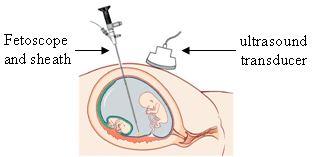
Fetoscopy is an endoscopic procedure during pregnancy to allow surgical access to the fetus, the amniotic cavity, the umbilical cord, and the fetal side of the placenta. A small (3–4 mm) incision is made in the abdomen, and an endoscope is inserted through the abdominal wall and uterus into the amniotic cavity. Fetoscopy allows for medical interventions such as a biopsy or a laser occlusion of abnormal blood vessels or the treatment of spina bifida.

Corixidae is a family of aquatic insects in the order Hemiptera. They are found worldwide in virtually any freshwater habitat and a few species live in saline water. There are about 500 known species worldwide, in 55 genera, including the genus Sigara.
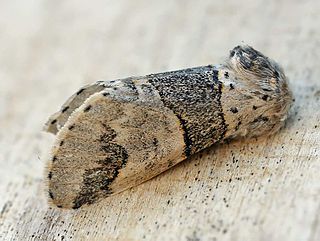
The poplar kitten is a species of moth in the family Notodontidae. The species was first described by Nikolaus Joseph Brahm in 1787. They are found throughout Europe and in North Africa, Mongolia, Kazakhstan and Xinjiang.

A hobcart was a type of mobility device designed in the late 1960s by Dr. Steven Perry of Albrighton, Shropshire, UK.
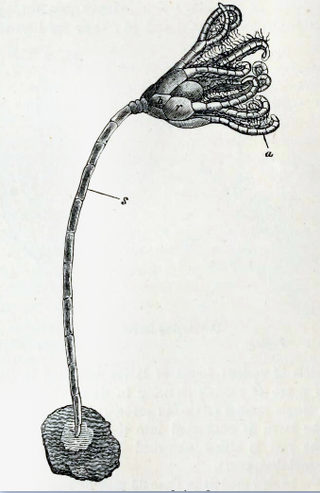
Antedon bifida is a species of crinoid in the family Antedonidae commonly known as the rosy feather star. It is found in north west Europe.

Galeopsis is a genus of annual herbaceous plants native to Europe and Asia. Members of this genus often have common names ending in hemp-nettle or hempnettle. Some species are naturalized in North America and New Zealand.
Allagelena bifida is a species of spider in the family Agelenidae. It was first described by Wang in 1997 as Agelena bifida. It is native to China. It was transferred to the genus Allagelena in 2017.

Corixinae is a subfamily of aquatic bugs in the family Corixidae. There are at least 130 described species in Corixinae.
Cenocorixa dakotensis is a species of water boatman in the family Corixidae. It is found in North America.
Cenocorixa is a genus of water boatmen in the family Corixidae. There are about 12 described species in Cenocorixa.

Corixini is a tribe of water boatmen in the family Corixidae. There are about 9 genera and at least 30 described species in the genus Corixini.
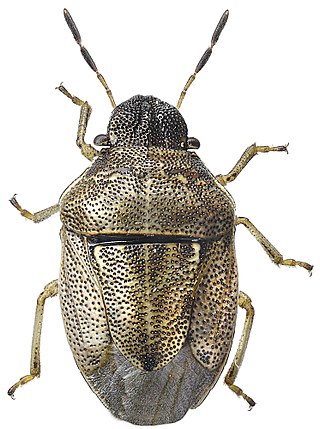
Neottiglossa is a genus of stink bugs in the family Pentatomidae. There are about 10 described species in Neottiglossa.
Parapsyche is a genus of netspinning caddisflies in the family Hydropsychidae. There are more than 20 described species in Parapsyche.

Thrinaxoria is a genus of flat-backed millipedes in the family Xystodesmidae. There are at least three described species in Thrinaxoria.
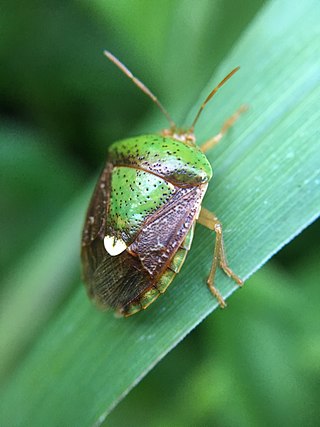
Edessa bifida is a species of stink bug in the family Pentatomidae. It is found in the Caribbean, Central America, North America, and South America. Some have proposed elevating the preexisting subgenus Ascra to genus status, thereby reclassifying E. bifida as Ascra bifida.

Colenis is a genus of round fungus beetles in the family Leiodidae. There are about eight described species in Colenis.
Cenocorixa expleta is a species of water boatman in the family Corixidae. It is found in North America.
Timothy Brei is a professor of neurodevelopmental pediatrics at the University of Washington and a developmental pediatrician at Seattle Children's Hospital. He is also the medical director of the Spina Bifida Association of America. Brei's research has focused on healthcare outcomes for children with spina bifida and as an adult with spina bifida who is an uncommon leader, he has also served as an advocate.












